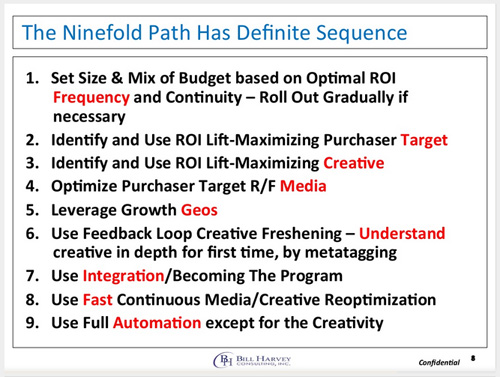The Ninefold Path to Marketing Transformation: Part 2 – Bill Harvey

Note: This was the title of my presentation at ARF's special conference at Simulmedia on March 3 with David Poltrack and Dave Morgan. Here's a link to a full video of the conference. (Read Part 1 of this series here.)
Here is the recipe we recommend for the programmatic future aimed at maximizing ROI on advertising investment. There are nine steps in all. Each one will add something more to your brand’s ROI. Even if you start with just one of them you will see marked improvement in your business. The one you add first may be more a matter of low hanging fruit than logic so feel free to start anywhere. However, in the long run the most efficient computerized system to assist you will eventually take the steps in the recommended sequence, for reasons I will explain.
The logical first step is to determine the optimal size of the overall budget. Traditionally this is set based on precedent: Whatever has been done before is the guideline. However, this is not necessarily what produces the best business outcome. Starting with an in-market test sufficient to gauge optimal frequency is enough to determine the overall budget, based on the axiom of Recency Demands Continuity, proven by John Philip Jones and Erwin Ephron based on research done by Jones and many other people including Leslie Wood (using ScanAmerica data, 1989). In other words if 3/week maximizes ROI due to maximizing the number of prospects who have recently seen one of your brand’s ads in the 48 hours before a shopping trip, maintaining that as the 52-week average frequency among the ROI Driving Target should be the purpose and first principle of the advertising plan.
This method may come out to putting a lot more money into advertising than you’d expect. But if that maximizes ROI it is the sensible thing to do, even if it does not keep your head down.
That same initial test should also determine the purchaser fingerprints of the types of homes who are responding positively with their wallets to your current creative. It is this same ROI-Driving Segment that you use to analyze the optimal frequency level. You may find that only a very small portion of your total purchaser base is actually driving the sales response to your current creative. The implicit hidden premium you are currently paying to reach these people may be in the hundreds of dollars CPM. You consider use of addressable TV to reach those members of your ROI Driving Segment who can be reached with that medium today, since this would bring down your CPM to reach the 20%-25% or so that media can provide in 2015 via addressable TV.
In that same first in-market test you also learn which of your creative executions has the highest sales effect, and which one doesn’t have any, and so on, and you can change your commercial rotation plan accordingly to expose most the ones with the most sales power.
The preliminary in-market test, depending on whether you do it nationally or locally, will give you some indication as to the media (besides addressable TV) that most efficiently and effectively reach the ROI Driving Target for your brand. As you start rolling out nationally, these media indications will be changing all the time and you will want to continuously re-optimize and take advantage of tracking data that shows the ways sales response patterns change over time.
Those four cornerstones are the foundation: Frequency, Target, Creative and Media. In the fifth step you begin to accumulate enough data to inspect the hyperlocal geographies, identifying those areas where you have exceptional opportunity and can easily afford to double the media pressure by removing the lowest ROI components of your national plan, perhaps only 5%, allowing you to apply pressure in high sales opportunity geos, thereby leveraging the brand’s total adspend.

You have run enough creative at this point to be able to understand more about what in certain ads is causing sales to go up, and what in the failed executions went wrong so that no sales effect occurred. The RMT DriverTagsTM is the first CreativeGenomeTM that purports to understand how creative internally functions along vectors of human values, needs, wants, motivations, aspirations, moods and emotions. As one of the creators of DriverTagsTM, I am excited by them and yet I also know that many other marketing scientists will follow the path of DTags and develop their own systems, all of which may have its own contribution to the marketing science of the future. This is an important step, because it goes beyond just judging creative on one monolithic evaluative scale and into deconstructing its invisible interior moving parts.
Branded integration into the program is a very successful technique already in mass scale. ROI measurements by TRA/TiVo Research and others have established that a successful integration can not only increase sales it can even increase ROI despite the added cost (about 60% of TRA cases show ROI lift and 100% show sales lift as of this writing). Cast presenter commercials, live read as it’s called on radio, are so much more effective they justify the often high expense.
The programmatic optimizer by which realtime improvements are continuously made to the advertising plan, as insight is refreshed by new feedback loop data, is itself an important contributor to ROI. No longer will brands be waiting up to one year to refresh their insights.
Much more can be done with automation than is being presently exploited. TV sellers have not made it any easier until now, but they are helping to lead the charge, which is terrific news. The awareness that everyone is on the same side is beginning to take hold, so that networks do not want to zero-sum the brand’s game by “trumping preference with price” as Irwin Gotlieb so aptly describes it. That too is in the process of becoming a trailing edge way of doing business.
Now everyone’s game is to get the sales and ROI lift to its highest level, retain the brand’s advertising business and expand it based upon proof that the entire process is in the brand’s own self-interest.
Bill Harvey is a well-known media researcher and inventor who co-founded TRA, Inc. and is its Strategic Advisor. His nonprofit Human Effectiveness Institute runs his weekly blog on consciousness optimization. Bill can be contacted at bill@billharveyconsulting.com
Strategic Advisor. His nonprofit Human Effectiveness Institute runs his weekly blog on consciousness optimization. Bill can be contacted at bill@billharveyconsulting.com
Read all Bill’s MediaBizBloggers commentaries at In Terms of ROI.
Check us out on Facebook at MediaBizBloggers.com
Follow our Twitter updates at @MediaBizBlogger
The opinions and points of view expressed in this commentary are exclusively the views of the author and do not necessarily represent the views of MediaBizBloggers.com management or associated bloggers. MediaBizBloggers is an open thought leadership platform and readers may share their comments and opinions in response to all commentaries.
Image at top courtesy of freedigitalphotos.net


